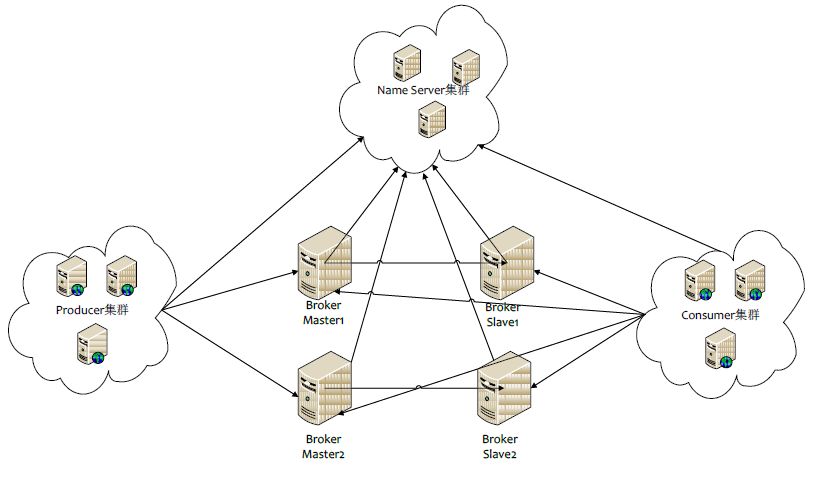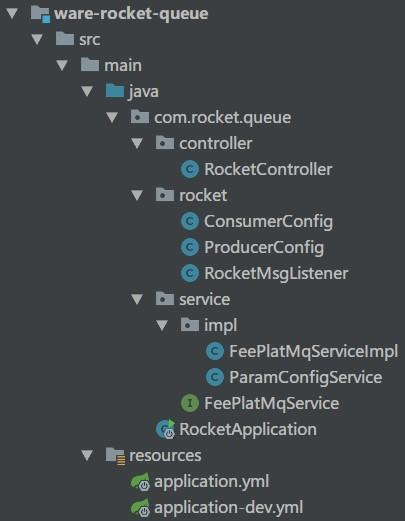1. RocketMQ
1. Architecture picture

2. Role classification
(1)、Broker
The core of RocketMQ is to receive messages from Producers, process consumer message requests from Consumers, store messages persistently, and filter on the server side.
(2)、NameServer
The state server in the message queue, through which each component of the cluster learns global information. Similar to the concept of service registration, discovery, offline, and online in the registry in microservices.
Hot backup: Multiple NamServers can be deployed independently of each other, and other roles report status information to multiple NameServer machines at the same time.
Heartbeat mechanism: The status information such as Broker and Topic in NameServer will not be stored persistently. They are regularly reported by each role and stored in memory. If the time-out is not reported, NameServer will consider that a certain machine fails and is unavailable.
(3)、Producer
The producer of the message, the most commonly used producer class is DefaultMQProducer.
(4)、Consumer
The consumer of the message, the commonly used Consumer class DefaultMQPushConsumer automatically calls the incoming processing method to process the message after receiving the message, with high real-time performance and high flexibility.
3. Communication mechanism
(1) After the Broker is started, it needs to complete the operation of registering itself to the NameServer; then update the topic routing information to the NameServer regularly every 30s.
(2) When the Producer sends a message, it needs to obtain routing information from the local cache according to the topic of the message. If not, the updated routing information will be pulled from the NameServer again, and the Producer will pull the routing information from the NameServer every 30s by default.
(3) When the Consumer consumes messages, it obtains the routing information from the NameServer, and after completing the load balancing of the client, listens to the specified message queue to obtain messages and consumes them.
Second, the code implementation case
1. Project structure diagram

Version description
<spring-boot.version>2.1.3.RELEASE</spring-boot.version>
<rocketmq.version>4.3.0</rocketmq.version>
2. Configuration file
rocketmq:
# 生产者配置
producer:
isOnOff: on
# 发送同一类消息的设置为同一个group,保证唯一
groupName: FeePlatGroup
# 服务地址
namesrvAddr: 10.1.1.207:9876
# 消息最大长度 默认1024*4(4M)
maxMessageSize: 4096
# 发送消息超时时间,默认3000
sendMsgTimeout: 3000
# 发送消息失败重试次数,默认2
retryTimesWhenSendFailed: 2
# 消费者配置
consumer:
isOnOff: on
# 官方建议:确保同一组中的每个消费者订阅相同的主题。
groupName: FeePlatGroup
# 服务地址
namesrvAddr: 10.1.1.207:9876
# 接收该 Topic 下所有 Tag
topics: FeePlatTopic~*;
consumeThreadMin: 20
consumeThreadMax: 64
# 设置一次消费消息的条数,默认为1条
consumeMessageBatchMaxSize: 1
# 配置 Group Topic Tag
fee-plat:
fee-plat-group: FeePlatGroup
fee-plat-topic: FeePlatTopic
fee-account-tag: FeeAccountTag
3. Producer configuration
import org.apache.rocketmq.client.exception.MQClientException;
import org.apache.rocketmq.client.producer.DefaultMQProducer;
import org.slf4j.Logger;
import org.slf4j.LoggerFactory;
import org.springframework.beans.factory.annotation.Value;
import org.springframework.context.annotation.Bean;
import org.springframework.context.annotation.Configuration;
/**
* RocketMQ 生产者配置
*/
@Configuration
public class ProducerConfig {
private static final Logger LOG = LoggerFactory.getLogger(ProducerConfig.class) ;
@Value("${rocketmq.producer.groupName}")
private String groupName;
@Value("${rocketmq.producer.namesrvAddr}")
private String namesrvAddr;
@Value("${rocketmq.producer.maxMessageSize}")
private Integer maxMessageSize ;
@Value("${rocketmq.producer.sendMsgTimeout}")
private Integer sendMsgTimeout;
@Value("${rocketmq.producer.retryTimesWhenSendFailed}")
private Integer retryTimesWhenSendFailed;
@Bean
public DefaultMQProducer getRocketMQProducer() {
DefaultMQProducer producer;
producer = new DefaultMQProducer(this.groupName);
producer.setNamesrvAddr(this.namesrvAddr);
//如果需要同一个jvm中不同的producer往不同的mq集群发送消息,需要设置不同的instanceName
if(this.maxMessageSize!=null){
producer.setMaxMessageSize(this.maxMessageSize);
}
if(this.sendMsgTimeout!=null){
producer.setSendMsgTimeout(this.sendMsgTimeout);
}
//如果发送消息失败,设置重试次数,默认为2次
if(this.retryTimesWhenSendFailed!=null){
producer.setRetryTimesWhenSendFailed(this.retryTimesWhenSendFailed);
}
try {
producer.start();
} catch (MQClientException e) {
e.printStackTrace();
}
return producer;
}
}
4. Consumer configuration
import org.apache.rocketmq.client.consumer.DefaultMQPushConsumer;
import org.apache.rocketmq.client.exception.MQClientException;
import org.apache.rocketmq.common.consumer.ConsumeFromWhere;
import org.slf4j.Logger;
import org.slf4j.LoggerFactory;
import org.springframework.beans.factory.annotation.Value;
import org.springframework.context.annotation.Bean;
import org.springframework.context.annotation.Configuration;
import javax.annotation.Resource;
/**
* RocketMQ 消费者配置
*/
@Configuration
public class ConsumerConfig {
private static final Logger LOG = LoggerFactory.getLogger(ConsumerConfig.class) ;
@Value("${rocketmq.consumer.namesrvAddr}")
private String namesrvAddr;
@Value("${rocketmq.consumer.groupName}")
private String groupName;
@Value("${rocketmq.consumer.consumeThreadMin}")
private int consumeThreadMin;
@Value("${rocketmq.consumer.consumeThreadMax}")
private int consumeThreadMax;
@Value("${rocketmq.consumer.topics}")
private String topics;
@Value("${rocketmq.consumer.consumeMessageBatchMaxSize}")
private int consumeMessageBatchMaxSize;
@Resource
private RocketMsgListener msgListener;
@Bean
public DefaultMQPushConsumer getRocketMQConsumer(){
DefaultMQPushConsumer consumer = new DefaultMQPushConsumer(groupName);
consumer.setNamesrvAddr(namesrvAddr);
consumer.setConsumeThreadMin(consumeThreadMin);
consumer.setConsumeThreadMax(consumeThreadMax);
consumer.registerMessageListener(msgListener);
consumer.setConsumeFromWhere(ConsumeFromWhere.CONSUME_FROM_LAST_OFFSET);
consumer.setConsumeMessageBatchMaxSize(consumeMessageBatchMaxSize);
try {
String[] topicTagsArr = topics.split(";");
for (String topicTags : topicTagsArr) {
String[] topicTag = topicTags.split("~");
consumer.subscribe(topicTag[0],topicTag[1]);
}
consumer.start();
}catch (MQClientException e){
e.printStackTrace();
}
return consumer;
}
}
5. Message monitoring configuration
import com.rocket.queue.service.impl.ParamConfigService;
import org.apache.rocketmq.client.consumer.listener.ConsumeConcurrentlyContext;
import org.apache.rocketmq.client.consumer.listener.ConsumeConcurrentlyStatus;
import org.apache.rocketmq.client.consumer.listener.MessageListenerConcurrently;
import org.apache.rocketmq.common.message.MessageExt;
import org.slf4j.Logger;
import org.slf4j.LoggerFactory;
import org.springframework.stereotype.Component;
import org.springframework.util.CollectionUtils;
import javax.annotation.Resource;
import java.util.List;
/**
* 消息消费监听
*/
@Component
public class RocketMsgListener implements MessageListenerConcurrently {
private static final Logger LOG = LoggerFactory.getLogger(RocketMsgListener.class) ;
@Resource
private ParamConfigService paramConfigService ;
@Override
public ConsumeConcurrentlyStatus consumeMessage(List<MessageExt> list, ConsumeConcurrentlyContext context) {
if (CollectionUtils.isEmpty(list)){
return ConsumeConcurrentlyStatus.CONSUME_SUCCESS;
}
MessageExt messageExt = list.get(0);
LOG.info("接受到的消息为:"+new String(messageExt.getBody()));
int reConsume = messageExt.getReconsumeTimes();
// 消息已经重试了3次,如果不需要再次消费,则返回成功
if(reConsume ==3){
return ConsumeConcurrentlyStatus.CONSUME_SUCCESS;
}
if(messageExt.getTopic().equals(paramConfigService.feePlatTopic)){
String tags = messageExt.getTags() ;
switch (tags){
case "FeeAccountTag":
LOG.info("开户 tag == >>"+tags);
break ;
default:
LOG.info("未匹配到Tag == >>"+tags);
break;
}
}
// 消息消费成功
return ConsumeConcurrentlyStatus.CONSUME_SUCCESS;
}
}
6. Configuration parameter binding
import org.springframework.beans.factory.annotation.Value;
import org.springframework.stereotype.Service;
@Service
public class ParamConfigService {
@Value("${fee-plat.fee-plat-group}")
public String feePlatGroup ;
@Value("${fee-plat.fee-plat-topic}")
public String feePlatTopic ;
@Value("${fee-plat.fee-account-tag}")
public String feeAccountTag ;
}
7. Message sending test
import com.rocket.queue.service.FeePlatMqService;
import org.apache.rocketmq.client.producer.DefaultMQProducer;
import org.apache.rocketmq.client.producer.SendResult;
import org.apache.rocketmq.common.message.Message;
import org.springframework.stereotype.Service;
import javax.annotation.Resource;
@Service
public class FeePlatMqServiceImpl implements FeePlatMqService {
@Resource
private DefaultMQProducer defaultMQProducer;
@Resource
private ParamConfigService paramConfigService ;
@Override
public SendResult openAccountMsg(String msgInfo) {
// 可以不使用Config中的Group
defaultMQProducer.setProducerGroup(paramConfigService.feePlatGroup);
SendResult sendResult = null;
try {
Message sendMsg = new Message(paramConfigService.feePlatTopic,
paramConfigService.feeAccountTag,
"fee_open_account_key", msgInfo.getBytes());
sendResult = defaultMQProducer.send(sendMsg);
} catch (Exception e) {
e.printStackTrace();
}
return sendResult ;
}
}
Welcome everyone to pay attention to my personal WeChat public account, which not only has technology sharing, but also industry interesting stories, making your life more interesting, pay attention and don't get lost!
